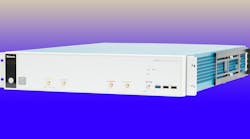Tektronix has been particularly busy of late bringing new test-and-measurement equipment to the market. One recent unveiling is the 6 Series low-profile digitizer (model number LPD64) (see figure). The company states that this new high-speed digitizer “has the functionality of a digitizer and the power of an oscilloscope,” and that its hardware platform is similar to the 6 Series MSO oscilloscopes.
The 6 Series low-profile digitizer is equipped with four channels and offers a sample rate as high as 25 Gsamples/s.
Equipped with four-channels, the 6 Series low-profile digitizer offers as much as 8 GHz of bandwidth and achieves a sample rate as high as 25 Gsamples/s. Supplied in a 2U form factor, the digitizer also features 12-bit analog-to-digital converters (ADCs) and has a standard record length of 125 Mpoints (the record length can be extended to 250 Mpoints as an option). Furthermore, SMA connectors provide the interface for all four channel inputs.
A key component for all channels is a real-time digital downconverter (DDC)—it allows for a capture bandwidth as high as 2 GHz when equipped with an optional analysis capability. Additional options provide customers with features like remote I/Q data transferring and RF versus time analysis.
Looking under the hood of the 6 Series low-profile digitizer reveals the Tektronix-designed TEK049 application-specific integrated circuit (ASIC). This ASIC contains 12-bit ADCs, which provide 16 times more resolution than traditional 8-bit ADCs. The TEK049 is paired with the TEK061 front-end ASIC, which, according to the company, enables “breakthrough” noise performance at the highest sensitivity settings. Thanks to the TEK061, RMS noise is only 54.8 µV at 1 mV/div with a 1-GHz bandwidth.


